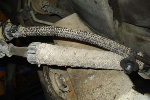SupaSwope
Well-Known Member
- Joined
- August 5, 2016
- Messages
- 328
- Reaction score
- 22
- City, State
- Florida
- Year, Model & Trim Level
- 99 Mountaineer 5.0 RWD
So I had a general question on If I should air down my tires a few psi over the recommended tire pressure when driving on hot days and or long trips when your psi rises some.
While trying to look threw some old threads I found this post.
Now I am still curious If I should air down my tires when they go up a few psi but I was running my 44 max psi tires at 26. The recommend psi on the door panel. I thought I was doing everything right but what should I be running my tires at? 30-35 with the front higher then the rear for traction? I mean it makes sense?
I am looking for a general discussion here and what are you/should you be using?
While trying to look threw some old threads I found this post.
Guys, guys, guys, stop talking about apples and oranges.
Different tires need different pressures. Way back when tires used to come with a 32psi max rating. Years ago that became 35psi, and lately tires come often with a 44psi max rating. None of these tires should be run at the exact same pressure.
Any tire should be run at some pressure within say, 8-10psi of the maximum rating. Anotherwords, a 44psi tire should never be run with less than 34-36psi, etc.
For maximum handling(safety), and gas mileage, set the pressure closer to the maximum. Lower pressures ride softer, but they create more heat(blow out), handle more poorly, and hurt gas mileage. Unless you have a 50/50 weight distribution, you should run a couple psi more in the front. This improves handling, and tire wear.
I usually have 44psi tires, and I use about 37-40psi in the front, and 35-37psi in the rear. The important factor is how far from the tire rating do you set the pressure.
Ignore any door jamb or manual psi listing. Those are for the stock tires for the smoothest ride(to sell you the car), not for longevity or safety.
If you look around you will see that there are tires now with ratings over 50psi. Large truck tires are usually rated over 60psi. Always start by checking the rating on the tire. Good luck all,
DW
Now I am still curious If I should air down my tires when they go up a few psi but I was running my 44 max psi tires at 26. The recommend psi on the door panel. I thought I was doing everything right but what should I be running my tires at? 30-35 with the front higher then the rear for traction? I mean it makes sense?
I am looking for a general discussion here and what are you/should you be using?










